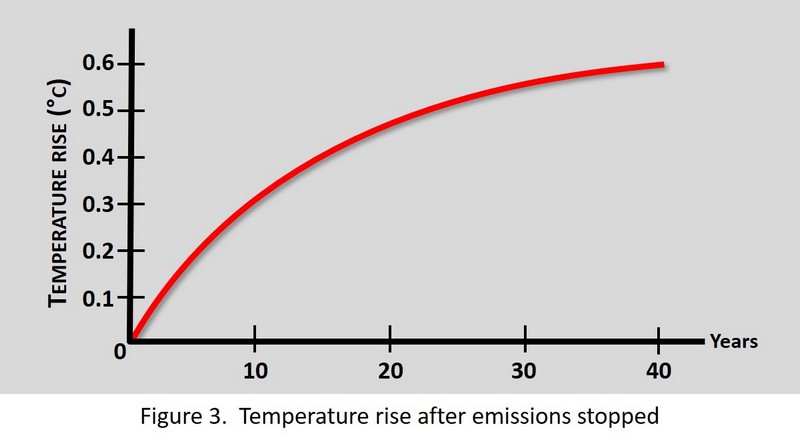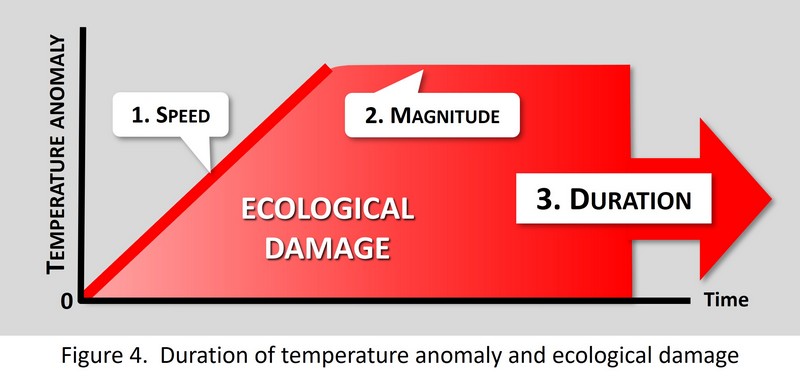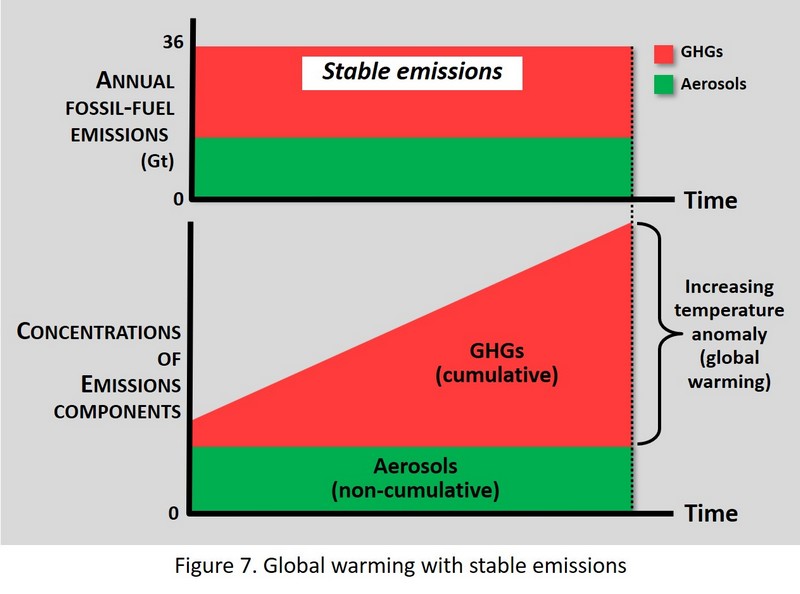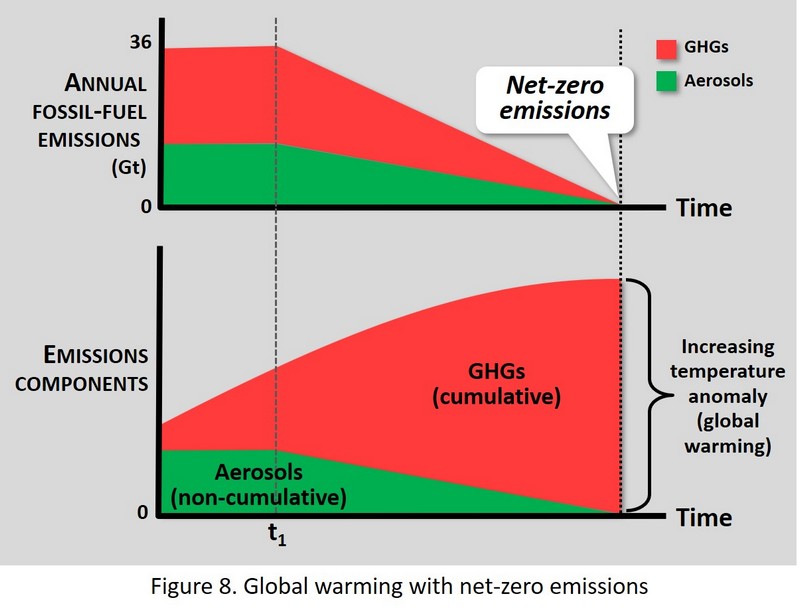Six Reasons to Reject the Emissions-reductions Story
By Frank Rotering | December 22, 2022
No matter where you get your climate news, the story you'll be told is basically the same: to avoid the worst consequences of climate change, fossil-fuel emissions must be aggressively reduced. Other measures, particularly solar radiation management (SRM), are dangerous distractions and must be categorically dismissed
This story, despite its almost universal acceptance, is a massive lie. Before explaining why, I must make two fundamental points:
First, the rational climate goal is not to "avoid the worst consequences" by slowing OR STOPPING global warming, but to return the Earth to Holocene temperatures through rapid global cooling. The current temperature anomaly of about 1.5°C must be negated as quickly as possible, so climate measures must be sharply focused on this goal.
Second, it is illogical to dismiss SRM because it cannot fully solve the climate crisis. The measure's limited purpose is to slow, halt, and then reverse the current warming, thereby granting time to remove excess GHGs from the atmosphere. Although SRM alone cannot achieve a safe climate, it is indispensable for short-term survival.
Let me now specify the six reasons for rejecting the emissions-reductions story.
REASON #1:
IT FALSIFIES THE UNFCCC OBJECTIVE
The UNFCCC agreement, which is the legal basis for the annual CoP meetings on climate change, was signed in 1992 and ratified by 197 countries in 1994. The following is Article 2, which specifies the agreement's objective:

The Article unambiguously states that the aim is to avoid dangerous climate change by maintaining GHG concentrations at safe levels. It does not mention emissions, and it rejects concentration levels that are unsafe. The standard story is therefore a blatant falsification of this critical accord.
Until a few years ago the media, climate scientists, and educational institutions spread this falsehood by simply asserting that the emissions-reductions story is consistent with UNFCCC Article 2. This changed in 2018, when a major Canadian university, in a video series on climate change, told an outright lie about the objective. The narrator stated that, "... the ultimate goal [of the agreement] was to stabilize GHG emissions at a level that would prevent dangerous climate change." Later that year The Atlantic magazine repeated this falsehood. The New York Times did the same in 2021, and The Guardian followed in 2022. For details on this extraordinary media dishonesty see my post, "Black is White: Climate Deception becomes Orwellian".
The decisive factor in falsifying the UNFCCC objective was the IPCC's second assessment report in 1995. In section 1.7 the organization ignored the safe-concentrations requirement and unilaterally shifted the objective to reduced emissions. This is the relevant text:
"Given current trends of increasing emissions of most greenhouse gases, atmospheric concentrations of these gases will increase through the next century and beyond. With the growth in atmospheric concentrations of greenhouse gases, interference with the climate system will grow in magnitude and the likelihood of adverse impacts from climate change that could be judged dangerous will become greater. Therefore, possible pathways of future net emissions were considered which might lead to stabilization at different levels and the general constraints these imply." (Emphasis added.)
Figure 2 depicts the disastrous results:

In 1995 the CO2 concentration was 360 ppm. The standard assumption is that 350 ppm is safe, so the IPCC should have mandated an immediate concentration decrease, as depicted by the heavy dashed line. However, its shift to reduced emissions meant that the CO2 concentration continued its rapid rise. This resulted in the deadly heat that is now destroying human civilization and life on Earth. Because the IPCC has been cloaked in the mantle of unassailable authority, this grotesque betrayal has never been exposed or challenged.
REASON #2:
IT IGNORES THE TEMPERATURE RISE AFTER EMISSIONS STOP
Climate scientists frequently tell us that "every tenth of a degree matters". What they rarely explain is that many such increments will occur even if all emissions are immediately halted. This is largely due to the thermal inertia of the world's oceans, which store over 90% of the excess heat from global warming. As shown in figure 3, a rough estimate of the temperature increase is 0.6°C over forty years. However, two studies (see here and here) conclude that the increase could be one degree Celsius or even more.
Given that human survival will require a rapid decrease in the global temperature, emissions reductions take us in exactly the wrong direction - even if they are 100% successful. This means that, if survival is truly the objective, this measure is completely irrational.
REASON #3:
IT IGNORES THE DURATION OF THE TEMPERATURE ANOMALY
The falsification of UNFCCC Article 2 shifted the world's attention from safe GHG concentrations to reduced emissions. This permitted concentrations to rise far above their safe levels, resulting in a temperature anomaly that has now reached 1.5C. The standard story asserts that the global temperature will stabilize when emissions hit net-zero, thereby solving the climate crisis.
The initial part of this statement is misleading. As just noted, the global temperature will continue to increase for several decades after concentrations stop rising. But even after the temperature has stabilized, the climate crisis will continue because the fundamental issue is ecological damage. As shown in figure 4, this is determined by the speed, magnitude, AND DURATION of the temperature rise. In other words, ecological damage increases with the area under the magnitude line, not just the height it reaches.
Why is this so? Because heat will continue to accumulate in Earth systems and ice will continue to disappear until the anomaly is removed - that is, until the global temperature returns to its pre-industrial, Holocene level. This is why the UNFCCC objective specifies that concentrations (and thus the global temperature) must be stabilized at safe levels, not at today's deadly levels.
REASON #4:
IT ADDRESSES ONLY 2% OF THE TEMPERATURE ANOMALY
If you had a potentially fatal fever, would you want a doctor to reduce your body's temperature to normal, or just minimize its further increase? If you want to survive, your answer will clearly be the first. Nevertheless, the standard climate story chooses the equivalent of the second.
This story tells us to rapidly reduce fossil-fuel emissions. However, emissions cause additions: increments to existing GHG concentrations. Acting on emissions therefore addresses only the increases to the temperature anomaly - the existing anomaly is completely ignored. As illustrated in figure 5, emissions represent only a small fraction of the excess heat that is now destroying the biosphere.
The figure uses CO2 as the representative GHG. If we assume that the global temperature is safe at 350 ppm and today's level is 425 ppm, the unsafe CO2 concentration is 75 ppm. Emissions cause the CO2 concentration to rise by about 2.5 ppm annually - an average of 1.25 ppm over the year. Hence, for the year cited, the planet will be dangerously warmed by 75 ppm from the existing unsafe CO2 concentration, and by an average of 1.25 ppm from CO2 emissions. This means that emissions reductions address less than 2% of the global heat problem, leaving more than 98% untouched.
REASON #5:
IT IGNORES THE LOSS OF AEROSOL COOLING
One of the many verbal tricks used by mainstream sources is to equate fossil-fuel emissions with CO2 or GHG emissions. In fact, such emissions contain not just GHGs, but also aerosols. These are liquid or solid particles that are suspended in the atmosphere, and that have climate attributes which differ sharply from GHGs (see figure 6 below). Terms such as "CO2 emissions" neglect the aerosols and lead people to believe that emissions contain CO2 alone.
To overcome this impediment to our understanding we should imagine not one but TWO smokestacks (or tailpipes, etc.) on a polluting facility - see figure 6. This allows us to picture GHGs coming from one and aerosols from the other, and thus to consider their distinct attributes in climate analysis.
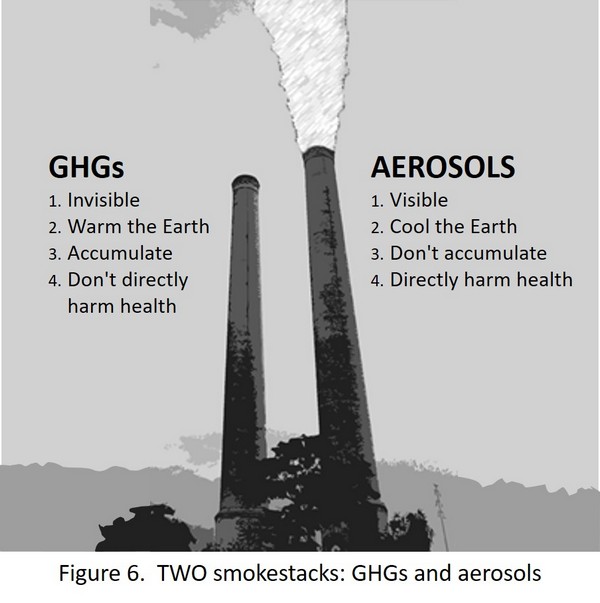
To avoid the misleading word "emissions", I refer to these separate flows as "GHG releases" and "aerosol releases". The standard story fails to make this crucial distinction. As explained next, this has grave implications for the analysis of global warming and the formulation of effective climate solutions.
Proponents of the emissions-reductions story claim that reducing fossil-fuel emissions will reduce the rate of global warming. This certainly seems plausible: emissions cause warming, so reducing them should slow it down. The conclusion is nevertheless false because of the distinct climate attributes of GHGs and aerosols.
As noted in figure 6, GHGs warm the Earth and accumulate in the atmosphere, whereas aerosols have a cooling effect and are quickly removed through rain and gravity. The graphs in figures 7 and 8 will help explain why this matters greatly when net-zero is pursued.
The above figure depicts the case where emissions are stable over a specified time period. The GHGs in these emissions will be added to those already in the atmosphere, resulting in a linear increase in the overall GHG concentration. In the absence of aerosols, this increase would also represent the rising temperature anomaly, which we know as global warming.
However, aerosols are also present. Because emissions are stable, a steady supply of aerosols is being pumped into the atmosphere. This means that new aerosols will replace those that have been removed, resulting in a constant level. Aerosols have a cooling effect, so the temperature anomaly is correspondingly reduced. Because the GHG warming is greater than the aerosol cooling, the net result is an increasing temperature anomaly.
Now let's look at the case where fossil-fuel emissions decrease to net-zero.
Emissions are stable until time t1, when effective measures to reduce them are implemented. This means that progressively less GHGs are added to existing concentrations, resulting in their stabilization when net-zero is achieved. The warming effect from GHGs is therefore reduced compared to stable emissions. However, as emissions decline, progressively less aerosols enter the atmosphere to replace those that have been removed, resulting in declining levels. At net-zero, aerosols and their cooling effect have completely disappeared.
Quantitatively these two effects - reduced warming from GHG stabilization and reduced cooling from aerosol disappearance - are roughly comparable. This means that the rate of global warming is not reduced, and that the final temperature anomalies in the two cases are approximately the same.
From this analysis it might appear that aerosols should remain stable or even rise to counter global warming. However, as noted in figure 6, low-altitude aerosols directly harm human health. The optimal aerosol level is therefore the one that, based on scientific and ethical criteria, balances its beneficial cooling and damaging health effects. Because aerosol releases are largely a local phenomenon, this judgment should be made at the local level.
Briefly stated, GHG releases must be minimized, but aerosol releases must be optimized.
Ignoring the loss of aerosol cooling has caused immense climate harm. Starting in 2012 the International Maritime Organization mandated major reductions in the sulfur content of ship fuels. These and other pollution measures sharply reduced the Earth’s albedo, or reflectivity. Astoundingly, this reduction has the same warming effect as increasing the atmosphere's CO2 concentration by 138 ppm. Because CO2 normally increases by 2.5 ppm annually, this is equivalent to 55 years of rising CO2 levels.
REASON #6:
IT DISMISSES THE CORE CLIMATE MEASURE: SRM
As explained above, the standard story about emissions reductions is scientifically untenable on multiple grounds. However, its most egregious feature is that it dismisses the only measure that can reverse global warming in time for human survival: solar radiation management. The existential significance of SRM, which is also called solar geoengineering, can be explained with the help of figure 9.
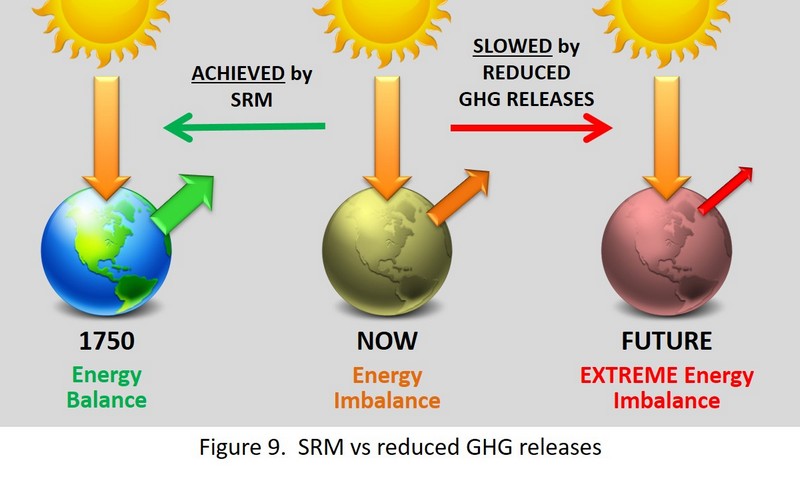
The critical concept, which is rarely discussed by mainstream sources, is energy balance. The Earth is in energy balance when the energy flowing from the Sun to the Earth is equal to the energy flowing from the Earth to space. As shown at left in the diagram, this was the situation in 1750, prior to the Industrial Revolution. As GHG concentrations increased, progressively less energy could escape from the Earth. As shown in the center, this resulted in today's energy imbalance and its associated 1.5°C temperature anomaly. The right side of the diagram depicts the extreme imbalance that will develop unless effective measures are implemented.
The top of the diagram shows that SRM is unique in its capacity to achieve global cooling. Reducing GHG releases can moderate global warming, but cannot cool the Earth. Only two methods can achieve this end: GHG removal (GGR) and SRM. Unfortunately GGR at scale is infeasible due to energy and material constraints, and it would be far too slow for our survival. The only measure that remains is SRM. Its dismissal by the emissions-reductions story is therefore a rejection of global cooling and a commitment to further warming. As is now evident, this path is catastrophic for both humankind and the natural world.
To summarize, the standard story about emissions reductions is a glaring falsehood that relies on multiple crude lies. Specifically, the measure falsifies the UNFCCC objective, ignores the temperature rise after emissions stop, disregards the duration of the temperature anomaly, addresses only a small fraction of this anomaly, fails to acknowledge the aerosol cooling effect, and dismisses the only measure that can achieve rapid global cooling - SRM.
The conclusion is clear: unless emissions reductions are replaced by the rational response - minimized GHG releases, locally optimized aerosol releases, and large-scale SRM - a disastrous climate future will inevitably unfold.
Edits:
June, 2023
July, 2024
April, 2025
